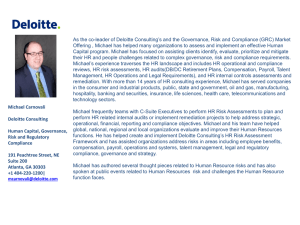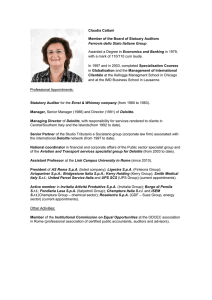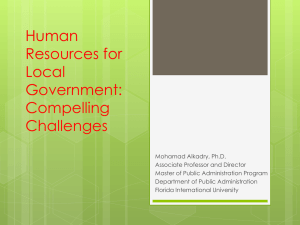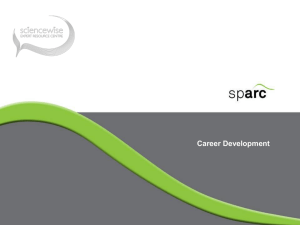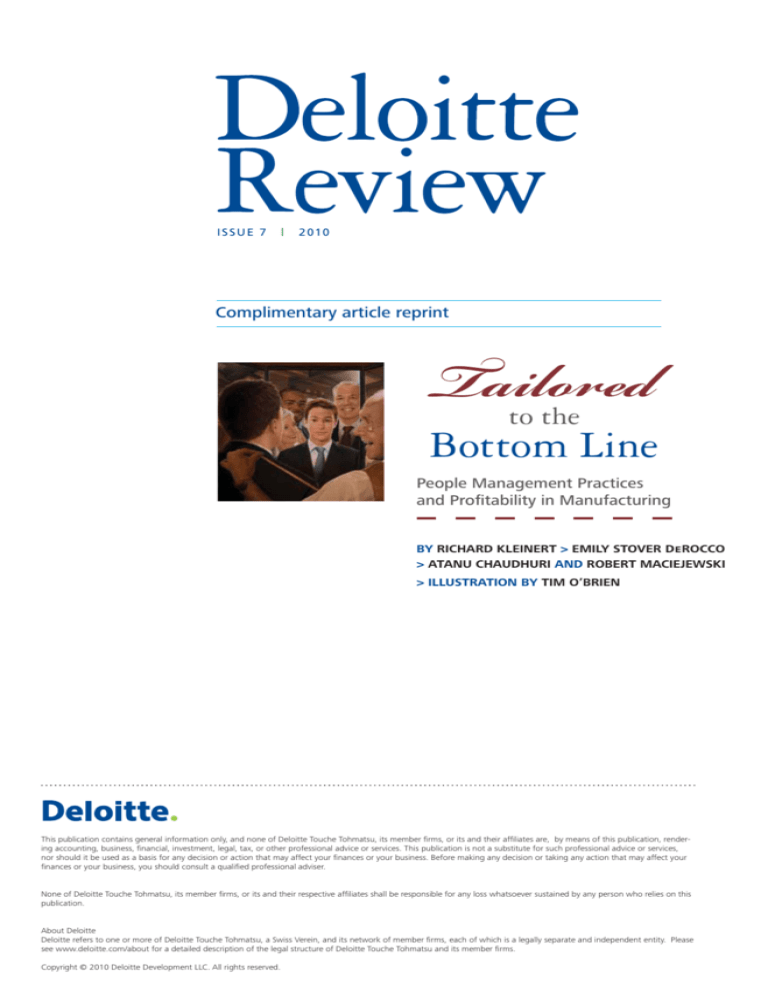
issue 7 |
2 010
Complimentary article reprint
Tailored
to the
Bottom Line
People Management Practices
and Profitability in Manufacturing
By Richard Kleinert > Emily Stover DeRocco
> Atanu Chaudhuri and Robert Maciejewski
> illustration by Tim O’Brien
This publication contains general information only, and none of Deloitte Touche Tohmatsu, its member firms, or its and their affiliates are, by means of this publication, rendering accounting, business, financial, investment, legal, tax, or other professional advice or services. This publication is not a substitute for such professional advice or services,
nor should it be used as a basis for any decision or action that may affect your finances or your business. Before making any decision or taking any action that may affect your
finances or your business, you should consult a qualified professional adviser.
None of Deloitte Touche Tohmatsu, its member firms, or its and their respective affiliates shall be responsible for any loss whatsoever sustained by any person who relies on this
publication.
About Deloitte
Deloitte refers to one or more of Deloitte Touche Tohmatsu, a Swiss Verein, and its network of member firms, each of which is a legally separate and independent entity. Please
see www.deloitte.com/about for a detailed description of the legal structure of Deloitte Touche Tohmatsu and its member firms.
Copyright © 2010 Deloitte Development LLC. All rights reserved.
112
Deloitte Review
d e l o i t t e r e v i e w. c o m
Tailored
ta i l o r e d t o t h e b o t t o m l i n e
to the
Bottom Line
People Management Practices
and Profitability in Manufacturing
By Richard Kleinert > Emily Stover DeRocco
> Atanu Chaudhuri and Robert Maciejewski
> illustration by Tim O’Brien
P
eople are billed as companies’ most important asset so routinely that we should be surprised they
don’t all sleep nights in a corporate vault. Yet, in the
hard-nosed, bottom-line discipline of managing organizations,
the “soft skills” of people management practices are more often
an afterthought than a core strategy linked to superior business
performance. And while manufacturers’ workforce management
practices have moved far beyond the personnel office of decades
past—with its origins in managing masses of low-skilled workers in a pre-technological age—many have a long way to go to
engage their people and connect these practices to shareholder
value. Talent management for many manufacturers could be
characterized as a less than ideal blend of new aspirations and
old tactics.
Consistent with a bottom-line approach, it is fair to ask:
How do people management practices impact the performance
of a company? Have these practices in your company kept pace
with the changes in your business? Most importantly, which
practices contribute to profitability?
d e l o i t t e r e v i e w. c o m
Deloitte Review
113
114
ta i l o r e d t o t h e b o t t o m l i n e
The road to useful conclusions is often paved with hard data. In our research,1
we found that answers to some of these questions lay in excellence in specific aspects of people management practices. The data suggest that certain practices help
some manufacturers outshine the rest. These companies have developed clear talent
management strategies that align consistently with their overall corporate strategy
and complement their culture and values in ways that point to improved results.
survey of manufacturing organizations
In May 2009, Deloitte*, The Manufacturing Institute and Oracle jointly conducted a national survey of manufacturing organizations to assess the current performance of companies with respect to people management practices, as well as the future importance
of these practices. They were asked to identify the top drivers of their future business
success and to comment on talent shortages experienced today and expected within the
next two to three years.
Profile of survey respondents
The survey was conducted via the Web, on an anonymous basis, to which 779 individuals responded. The distribution of respondents was as follows:
Primary industry sector:
Aerospace & Defense 6%
Automotive 6%
Consumer Products 9%
Energy & Resources 3%
Industrial Products
Life Sciences & Medical Devices All other 43%
2%
31%
Methodology
We sorted the respondents based on their self-reported earnings before interest, tax and depreciation (EBITDA) and identified the top quartile and bottom quartile companies based on
EBITDA. We tested for statistically significant differences in the current performance of each
of the people management practices between the bottom and top quartile EBITDA firms. We
performed a similar analysis for gauging the importance of their people management practices.
* As used in this article, “Deloitte” means Deloitte Consulting LLP, a subsidiary of Deloitte LLP. Please
see www.deloitte.com/us/about for a detailed description of the legal structure of Deloitte LLP and its
subsidiaries.
Deloitte Review
d e l o i t t e r e v i e w. c o m
ta i l o r e d t o t h e b o t t o m l i n e
What sets them apart
R
ecognizing that larger companies have the scale and resources to develop
more comprehensive talent management strategies, we focused our research
on the largest 142 companies from our survey. The most profitable large companies share three practice areas that differentiate them from the least profitable
companies:
• Defining a clear and explicit people strategy that is linked to the business
strategy.
• Performing formal succession planning across the workforce.
• Linking employee pay directly with productivity of the company or to the
respective manufacturing plant.
People and the end goal
Any business strategy ultimately depends on people for its successful execution.
Acquisitions, mergers, downsizing, offshoring, partnering, you name it – people
are central.2 But the people strategy needed to drive and support a high-end, intensive-customer-experience retail company is very different from that needed for
a mass merchandise, low-cost discount retailer, and vastly different from a customized, specialty engineering and manufacturing aerospace and defense firm. Yet relatively few employers surveyed have developed an explicit and documented people
strategy tailored to their business goals.
Of the largest companies that participated in the survey, 55 percent of those
with top quartile profitability rated themselves “high” in linking people management strategy to business strategy, while only 30 percent of bottom quartile profitability companies reported similar performance (figure 1). Among all the survey
respondents (regardless of size), the figures stand at 44 percent for the most profit-
Percentage of companies
Figure 1. Top three differentiators
70.00
57.58
54.55
60.00
45.5
50.00
40.00
30.00
30.3
36.36
30.3
20.00
10.00
0.00
Clear and explicit people
strategy linked to
business strategy
Formal succession planning
across the workforce
Low EBITDA
Employee pay directly linked
to productivity of company
or respective plant
High EBITDA
d e l o i t t e r e v i e w. c o m
Deloitte Review
115
116
ta i l o r e d t o t h e b o t t o m l i n e
able companies and 36 percent among the least profitable. In many organizations,
the HR function does not participate in the strategy development process nor does
it have complete visibility into corporate or business unit strategies. As a result,
corporate strategy and people strategy are developed independently and people
management practices may be misaligned with corporate objectives. For example,
an industrial products company may develop a strategy to increase its service revenues by 20 percent over the next three years, but if it fails to measure and improve
service orientation among employees, it will likely fail to achieve that objective and
may also find its employees demotivated.
The most profitable companies, the data would suggest, align people practices
to corporate strategy. According to GE’s vice president of human resources for Australia and New Zealand, Sam Sheppard, rather than being an administrative function, HR initiatives, actions and priorities must be aligned with the business plan.
“There is no point being an add-on function, a reactive partner for the business,” Sheppard said. “It’s very easy sometimes to get sidetracked on what we would
like to be doing, but if we can’t translate that into a bottom-line impact for the
business, then that lessens our value to the organization.”3
After struggling with lack of focus and losses in the billions in the early 1990s,
Sears Holdings Corporation likewise overhauled its strategy implementation process. A senior management team incorporated the full range of performance drivers
into the process. Then, they articulated a new vision: For Sears to be a compelling
place for investors, the company must first become a compelling place to shop; and
for it to be a compelling place to shop, it must become a compelling place to work.
Sears validated the vision with hard data, designing a system to objectively
measure each of the three “compellings.” The team extended this approach by developing a series of related competencies that employees were required to hone
and identified behavioral objectives for each of the “compellings” at several levels through the organization. These competencies then became the foundation on
which the firm built its job design, recruitment, selection, performance management, compensation and promotion criteria. The company also instituted the Sears
University to develop these competencies.4
Recognizing that it is important for HR managers to be familiar with the
broader aspects of the business, Coca-Cola rotates top-performing line managers
into HR positions for two or three years to build the business skills of its HR
professionals and thus make the function more credible to the business units.
At Procter & Gamble, an HR manager is expected to work in a plant or work
alongside a key-account executive to learn more about the business and
its needs.5
Deloitte Review
d e l o i t t e r e v i e w. c o m
ta i l o r e d t o t h e b o t t o m l i n e
Formal succession planning across the workforce
Well-defined succession planning takes a long-term view of talent within the
organization. It develops talent to step into key roles on a timeline consistent with
anticipated—and unanticipated—vacancies. Lack of rigorous succession planning
can hit companies hard. It takes them longer to replace critical talent and often at
a higher cost from external sources.
Among the largest companies in our dataset, 45 percent of companies with
top quartile profitability exhibit high ratings in formal succession planning while
only 30 percent of bottom quartile companies performed similarly. Looking at all
respondents (regardless of size), 36 percent of the highly profitable companies rate
their current capabilities in formal succession planning as “high,” while only 20
percent of the less profitable companies rate themselves similarly. A majority have
yet to establish an effective succession planning process.
Many organizations struggle when it comes to grooming successors for key positions. Succession planning, as traditionally conceived and executed, is narrowly
focused on identifying employees who are ready for promotion, usually only at
senior executive levels. A long-term talent management strategy should look beyond the C-suite to prioritize succession of all critical positions based on specific
organizational needs and strategic direction.
According to Johnson & Johnson, the ability to groom future leaders is crucial
to removing a potentially significant constraint to its future growth. Each year
J&J’s CEO launches the talent review process with a letter addressed to executive vice presidents reinforcing the importance of leadership development and also
highlighting a new area of focus for that year to emphasize succession management
priorities. J&J uses bottom-up succession reviews to discover and grow talent first
at the operating company level, then at the group level, and finally at the corporate
level. As a result, talent review now takes place in every aspect of J&J’s business
planning with continuous examination of capabilities and development needs of
executives in the context of larger organizational needs.6
Colgate-Palmolive also developed an innovative way to ensure that all levels of management make succession planning a priority. It instituted a program that mandates that all senior managers must retain 90 percent of their
staff who have been designated as “high potential” or risk losing part of their
compensation.7
Linking employee pay to productivity
Among the largest companies in our survey, 58 percent with top quartile profitability ranked high in linking employee pay to productivity, while only 36 percent
d e l o i t t e r e v i e w. c o m
Deloitte Review
117
118
ta i l o r e d t o t h e b o t t o m l i n e
of bottom quartile companies performed similarly. Considering all respondents
(regardless of size), 55 percent of highly profitable companies rate their current
capabilities in linking employee pay to productivity as “high” compared to only 41
percent of the less profitable companies.
Organizations are increasingly placing emphasis on rewards management programs and performance-based pay. Deloitte’s 2010 Top Five Total Rewards Priorities Survey reports that 66 percent of respondents plan to make changes in the
design of compensation plans, with particular emphasis on performance-based pay
and performance management tracking and administration.8
Siemens successfully transformed its employee compensation system as part
of its value-based management program. Before launching the program, performance-related pay was a small proportion of total compensation, even for the most
senior executives. After the launch of the program, approximately 60 percent of
the remuneration of the top 500 executives became performance-related. Siemens
based this on current share price and investor expectations of the improvement in
economic value added over the next year.9
At Nucor Steel, employees involved directly in manufacturing are paid weekly
bonuses based on how much their work groups—each ranging from 20 to 40 workers—produce. Typically, these bonuses are calculated on anticipated production
time or tonnage produced, depending upon the type of facility. The formulae for
determining the bonuses are non-discretionary, based upon established production
goals. This plan creates pressure for each individual to perform well and, in some
facilities, is tied to attendance and tardiness standards.
Nucor department managers earn annual incentive bonuses based primarily on
the return on assets of their facility. Senior officers receive no profit sharing, pension
or discretionary bonuses. Instead, a significant part of each senior officer’s compensation is based on Nucor’s return on stockholders’ equity, above certain minimum
earnings. If Nucor does well, the officer’s compensation is well above average, as
much as several times base salary. If Nucor does poorly, the officer’s compensation
is only base salary and, therefore, significantly below the average pay for this type
of responsibility.10
Building current strengths, managing future priorities
M
anufacturing companies need not only take stock of their current people
management practices, but also to plan for the future importance of those
practices. They should identify practices of continued high priority and those in
need of improvement, given future business realities, while recognizing how certain practices are more impactful to their enterprise value.
Deloitte Review
d e l o i t t e r e v i e w. c o m
ta i l o r e d t o t h e b o t t o m l i n e
Apart from the top three differentiators, our research identified several other
people management practices to which the most profitable companies assign moderate to very high importance in the future and for which current performance
levels suggest room for improvement:
• Conducting formal orientation of new employees including familiarizing
them with corporate values.
• Explicitly defining technical competencies and evaluating these while
hiring.
• Measuring and recognizing strong performance using clear metrics and
methods of evaluation.
• Willingness to pay top performers significantly more than average employees.
Emphasis on core values and corporate culture will remain important in the
future. The majority of the most profitable companies already excel in that aspect.
In addition, those companies will sustain their efforts with regard to:
• Considering future talent needs in the recruitment process.
• Evaluating problem solving skills during the recruitment process.
• Explicitly defining non-technical competencies and evaluating these
in hiring.
• Sharing profits across the workforce.
• Using a defined contribution approach to the employee benefit program.
These high-priority practices fall broadly into three categories: people strategy
and culture, talent acquisition and development, and performance management.
People strategy and culture
High-performing companies align people management practices to the corporate culture (“cultural fit”) and to the business strategy and long-term objectives of
the organization (“strategic fit”).11 This tight coupling of internal practices, culture
and strategy remains unique for each organization and is difficult for competitors to
imitate. While rivals can poach a few employees or can try to mimic some strategic
moves, rarely will they be able to penetrate the lattice of internal fit, cultural fit
and strategic fit.
Our research suggests that higher percentages of highly profitable companies
excel in focusing on core values and corporate culture and on orienting employees
to that culture (figure 2).
d e l o i t t e r e v i e w. c o m
Deloitte Review
119
ta i l o r e d t o t h e b o t t o m l i n e
Figure 2. Emphasis and orientation on core values and culture
80
74.3
70
Percentage of respondents
120
62.2
57
60
48.3
50
40
30
20
10
0
Management has strong focus on core
values and corporate culture
New employees receive formal orientation
and mainstreaming instruction including
company values
Low profitability
High profitability
Companies that inspire employees can expect significant discretionary effort
from their workforce, who in turn can help win and retain customers.12
The Nokia Way defines Nokia’s core values. Nokia reviewed and refined these
values in 2007 to engage employees and to reflect how the business evolved and
changed. It asked employees to explain what was most important to them to help
create a new set of values that define Nokia. Over 2,500 employees from around
the world took part in 16 regional events to come up with the key themes for new
values. Involving employees at every stage of the process helped Nokia embed a
strong values culture throughout the business.
The new values, an evolution of the previous Nokia values, are:
• “Achieving Together,” which reflects that the company increasingly works
in networks.
• “Very Human,” which builds on Nokia’s previous value of “respect.”
• “Engaging You,” which includes all company stakeholders and not just
customers.
• “Passion for Innovation.”13
Nokia now communicates these values to all its employees through videos and
other information on its intranet and as part of its communications on company
strategy. In May 2007, around 13,000 employees registered in the Nokia Way Jam,
a 72-hour online discussion to decide on values and debate future business strategy.
The collaborative nature of the Jam was an expression of Nokia’s culture and the
Deloitte Review
d e l o i t t e r e v i e w. c o m
ta i l o r e d t o t h e b o t t o m l i n e
value it places on “achieving together.” Nokia analyzed the results of the Jam and
identified several key corporate initiatives to be included in future plans and several
initiatives within its business groups. The Jam prompted new activity and changed
some of Nokia’s business priorities.14
Talent acquisition and development
Highly profitable companies do a better job in their recruiting process by thoroughly analyzing technical, non-technical and problem solving skills. These companies consider recruitment as a dynamic process that is closely linked to the people
and corporate strategies. Thus, they work with the businesses to identify future
needs in terms of skill sets and proactively recruit such people ahead of the competition (figure 3).
Figure 3. Talent acquisition and development
Percentage of respondents
70
57.2
60
48.8
50
43.9
40
32.5
42.5
31.5
40.2
34.3
30
20
10
0
Technical competencies
are explicitly defined
and evaluated in
hiring process
Non-technical
competencies
(leadership, general
management and
interpersonal skills)
are explicitly defined
and evaluated in
hiring process
Low profitability
Future talent
needs, including
new types of
skills and expertise,
are considered
in ongoing
recruitment efforts
Problem solving
skills and
willingness to
change are
evaluated in
hiring process
High profitability
These companies measure return on investment (ROI) in the recruiting function and use metrics and analysis to optimize the most effective sources, programs
and methods.
Uncertain business conditions make workforce planning a tightrope walk for
most organizations. To conduct robust planning in such uncertain conditions, some
profitable companies borrow techniques from supply chain management, where
the overall task is similar to workforce planning. These companies have shifted
from forecasting to simulations. One large global chemical company started using
standardized data from its enterprise resource planning system to produce manpower estimates for each location that could be aggregated for the company as a
d e l o i t t e r e v i e w. c o m
Deloitte Review
121
122
ta i l o r e d t o t h e b o t t o m l i n e
whole. Then it sought a university to develop an even more elaborate model, one
that used the standardized data to generate estimates for each business unit. The
simulation-based models incorporated a wide range of site-specific factors such as
estimates of the political and business climate in each of its countries of operation,
changes in labor and employment legislation, and business plans for the operating
unit, which include targets for operating productivity. Those forecasts were then
aggregated into companywide estimates. This helped answer “what-if” scenarios:
What happens to forecasted headcount if the economy slides below assumption or
if new competitors enter a market? Simulation allows business leaders to see the
implications of different strategies for talent, to anticipate how talent constraints
could impact those strategies, and in some cases, to adjust their business plans if
the talent requirements are too extreme.15
To ensure the availability of highly skilled professionals, Caterpillar, its dealerships, and community and technical colleges work together to educate and train
high school graduates to become Caterpillar dealer service technicians. The twoyear “ThinkBIG” program—combining classroom work with hands-on learning in
labs and in the field—teaches students how to service Caterpillar equipment using
diagnostic and maintenance systems, advanced technologies and tools.16 Caterpillar
tests candidates applying for operations jobs on well-defined criteria like numerical
abilities, mechanical comprehension and information matching skills. After passing these tests, candidates are interviewed to obtain further information on their
achievements and qualifications.17
Performance management
An effective performance management system helps to develop the capabilities of individuals and teams to deliver sustained organizational performance. By
systematically evaluating and effectively rewarding high performance, the most
profitable companies succeed in retaining top talent. They are also able to align
behaviors and competencies of both the team and individuals with that of the organization to drive strategy execution (figure 4).
The most profitable companies design performance management as an ongoing
process, enhancing employee skills, competencies, knowledge and experience over
an extended period of time by regularly evaluating performance and capability.
A key challenge that organizations face while designing total rewards programs
is managing the trade-off between satisfying employees’ rewards preferences and
working with limited resources. Given resource constraints, companies can boost
total returns by emphasizing total rewards elements that increase commitment
among critical workforce segments – employee groups whose retention and motivation drive a disproportionate share of company success. These are the people
Deloitte Review
d e l o i t t e r e v i e w. c o m
ta i l o r e d t o t h e b o t t o m l i n e
Percentage of respondents
Figure 4. Performance management
70
61.1
60
47.6
50
60.0
46.7
58.4
46.7
40.6
40
32.5
30
20
10
0
There is a willingness
to pay top performers
at all levels significantly
more than average
employees
There is a broad
application of
profit sharing in
some form or
another across
the workforce
Low profitability
There is a defined
contribution
approach to
employee benefit
programs
Management
consistently
recognizes strong
performance, at all
employee levels,
using clear metrics
and methods of
evaluation
High profitability
a company can least afford to lose, whether outright to a competitor or indirectly
through lack of commitment, effort and productivity. Because of their disproportionate impact on the value chain, the specific views of these critical workforce
segments should be weighed heavily in order to maximize the ROI on reward
programs.18
Procter & Gamble has used its business and people strategies as the basis for
reviewing its long-term incentive (LTI) program for employees. The company has
applied two fundamental compensation principles in guiding the review: to pay
competitively and to support the business strategy. When P&G revisited its LTI
program, it carefully examined its people strategy to ensure that the revised LTI
plans would reflect the company’s build-from-within approach to talent management and the need for mobility of key people across the organization.
P&G looked at the employee value proposition (EVP) around work content,
career, direct and indirect financial benefits and affiliation. It analyzed the impact
of different LTI designs on diverse aspects of EVP across groups of employees with
different salary bands and located in different key growth geographies. It ensured
that the LTI designs adhered to a clearly articulated rewards strategy and that the
strategic business rationale for the compensation plans, including thorough analysis, was shared with employees. For analyzing the financial impact, P&G looked at
impact on cash flow and unwanted turnover. Then P&G leadership analyzed the
sensitivity of the LTI designs under different business performance scenarios. For
example, if performance were to exceed expectations, they determined the permissible maximum possible payouts and total payout costs to the organization. Thus,
P&G was able to fully appreciate the implications of different LTI designs on the
d e l o i t t e r e v i e w. c o m
Deloitte Review
123
124
ta i l o r e d t o t h e b o t t o m l i n e
organization and on critical workforce populations. Finally, P&G was able to design
an LTI which balanced the financial implications with the non-financial components of EVP.19
Create an integrated talent strategy
A
n effective talent management strategy is rooted in facts, not hunches or
blind guesses. The starting point is understanding the organization’s criti-
cal workforce segments – jobs that drive a disproportionate share of key business
outcomes, have the greatest impact on the value chain, and are in short supply from
the respective labor market. These segments of the workforce must be protected
and developed. This requires a workforce plan that analyzes and forecasts the talent
needed to execute the business strategy and then defines specific plans to fill the
expected gaps.
Strategy
Align
Analyze
Differentiate
Create a clear line of sight
between your business
and talent strategies
Get a fact-based understanding
of talent supply and demand
in the external market and
inside your company
Assess options and choose
a mix of talent and work
solutions that will drive
competitive advantage
• Ensure that talent
and business strategies
are integrated and
aligned
• Identify critical workforce
segments
• Define workforce analytics
to drive talent and work
solutions
• Understand and
evaluate Risk
Management issues
• Identify potential
linkages to HR strategy
• Determine competency
requirements
• Conduct internal and external
assessment of capabilities and
supply
• Conduct workforce planning
and forecasting
• Identify and analyze employeebased feedback mechanisms
• Develop talent roadmap: select
solutions to implement in line
with business priorities
• Assess influences of
generational differences
• Develop metrics: business case
and short and long-term
measures of success
No two companies—even those in the same sector—will have identical formulae for talent. Certain talent management capabilities are table stakes that are
required just to keep the company operating smoothly. Others can differentiate a
company from its competitors and provide a sustainable competitive advantage.
Once a company has identified its critical workforce segments, it must pay special attention to the preferences of people in those segments by investing in tailored programs to develop and retain them and help them achieve a high level of
productivity.20
Deloitte Review
d e l o i t t e r e v i e w. c o m
ta i l o r e d t o t h e b o t t o m l i n e
Manufacturers are facing unprecedented long-term business and talent challenges, a situation that offers tremendous opportunities for individual companies
to separate themselves from the pack. Our research suggests that certain people
management practices can help some manufacturers achieve superior profitability.
Through talent strategies that are innovative, forward looking and closely aligned
with the company’s overall strategy, a manufacturing organization can address its
short-term challenges while positioning itself for long-term success.21
Richard Kleinert is a principal with Deloitte Consulting LLP in the Human Capital practice.
Emily Stover DeRocco is president of The Manufacturing Institute.
Atanu Chaudhuri is a manager with Deloitte Research, Deloitte Support Services India Pvt. Ltd.
Robert Maciejewski is a senior manager with Deloitte Consulting LLP in the Human Capital practice.
Endnotes
1. “People and Profitability: A Time for Change - A 2009 People Management Practices Survey of the Manufacturing Industry,”
Deloitte Consulting LLP, The Manufacturing Institute and Oracle, 2009.
2. “The Chemistry of Talent: New Ways to Think about People and Work,” Deloitte Consulting LLP., 2008 <https://deloittenet.
deloitte.com/cm/IMO/IMO/Talent/Pages/Talent_STB_10.aspx>
3. Craig Donaldson, “Plugged in HR: the General Electric Strategy,” Human Resources Magazine, 2003 <http://www.humanresourcesmagazine.com.au/articles/a9/0c01c1a9.asp>.
4. Brian E. Becker, Mark A. Huselid, and Dave Ulrich, “The HR Scorecard: Linking People, Strategy, and Performance,” Harvard
Business School Press, 2001.
5. M. Guthridge and A.B. Komm, “Why Multinationals Struggle to Manage Talent” McKinsey Quarterly, May 2008, pp. 1–5.
6. “Practice #1: Executive Talent Growth Review,” Safeguarding Critical Business Capabilities, Corporate Executive Board,
2003.
7. Brent Cameron, “Succession Planning: Be Proactive, Not Reactive,” Odgers Berndtson <http://www.odgersberndtson.ca/
fileadmin/uploads/canada/Documents/PDFs/SuccessionPlanningOB.pdf>
8.“2010 Top Five Total Rewards Priorities Survey,” Deloitte Consulting LLP., 2010 <http://www.deloitte.com/assets/DcomUnitedStates/Local%20Assets/Documents/us_consulting_2010TopFiveTotalRewardsSurvey_022210.pdf>
9. Phillippe Haspeslagh, Tomo Noda and Fares Boulos, “It’s Not Just about the Numbers,” Harvard Business Review, July–August 2001, pp. 65–73.
10. Gregory P. Smith, “How Nucor Steel Rewards Performance and Productivity,” <http://www.businessknowhow.com/manage/
nucor.htm>
11. “Global Talent Management: How Leading Multinationals Build and Sustain their Talent Pipeline,” INSEAD Working Paper,
2007.
12. “Culture and the Myth of the Black Box,” Deloitte Review, 2007 <https://www.deloitte.com/assets/Dcom-UnitedStates/
Local%20Assets/Documents/US_deloittereview_Culture_and_the_Myth_of_the_Black_Box_aug07.pdf>
13. Nokia Corporate Responsibility Report 2007 <http://www.nokia.com/corporate-responsibility/cr-report-2007/employees/
embedding-our-values>
14. Ibid.
15. Peter Cappelli, “A Supply Chain Approach to Workforce Planning,” Organizational Dynamics, Vol. 38, No. 1, 2009, pp.
8–15.
16. Caterpillar Learning and Development, ThinkBig Technician Education <http://www.cat.com/cda/
layout?m=190511&x=7>.
17. Caterpillar: How we Hire <http://www.cat.com/cda/files/310599/7/COSPPracticeTestv2.pdf>.
18.“Rewards Transformation: Turning Total Rewards from a Cost into an Investment,” Deloitte Consulting Point of View,
2006.
19. Gibson J. Bradley, Blair Jones and Clare Hatfield, “Procter & Gamble’s Balanced Approach to Long-term Incentives,”
WorldatWork Journal, 1st Quarter 2005, pp. 6–14.
20.“Talent strategies for turbulent times: Ways to manage talent in a downturn – and beyond” Deloitte Consulting Point of
View, 2009
21. Ibid.
d e l o i t t e r e v i e w. c o m
Deloitte Review
125

